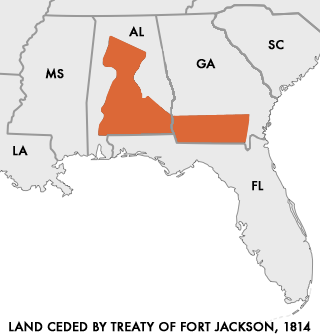Fort Jackson Treaty
The Treaty of Fort Jackson was a land assignment treaty signed on August 9, 1814 in Fort Jackson , Alabama between the Indian nation of Muskogee (Creek) and the United States Government, and ratified by the United States Congress on February 16, 1815 . With this agreement, the Muskogee gave up the rights to approximately 81,000 square kilometers of their ancestral tribal area in Alabama and Georgia and transferred them to the United States.
prehistory
The Confederation of Muskogee began in the first decade of the 19th century, to split into two main camps, the one in the Alabama Valley living "Upper Creek" (Engl. For Upper Creek ) and the Chattahoochee , Ocmulgee and Flint River settling "Lower Creek" (English for Lower Creek). The main point of contention between the conflicting parties was the differently accepted and practiced approach to the way of life of the white settlers, which was advocated by the Lower Creek, who lived close to the white settlers, and rejected by the Upper Creek, who lived further away. The latter sided with the British during both the American Revolution and the British-American War . The conflict culminated in 1813 and 1814 in " Red Stick War " (Engl. For war Rotstöcke ), a civil war between the anti-American and adaptable willing party within the Muskogee. With the victory of the pro-American Muskogee and American militia supporting them under Andrew Jackson in the Battle of Horseshoe Bend , the resistance of the traditionalists was finally broken. They surrendered in August 1814.
Contractual agreements
Jackson, who acted as negotiator for the United States, used the situation after the Civil War to defeat the defeated Upper Creek and the Lower Creek allies, which he accused of participating in the rebellion, the chiefs of the Muskogee, including William McIntosh , in the Call for contract negotiations at Fort Jackson, not far from Wetumpka , Alabama, on August 8 and force them to sign the Fort Jackson Treaty. In this treaty, the Muskogee gave the United States the rights to over half of their land, around 81,000 square kilometers (an area the size of Austria), as a kind of reparation payment for the damage and victims caused by the Creek War. In return, the Muskogee received the right to rule their nation sovereignly within the remaining area, but had to tolerate interference by the American government through trade and military posts as well as roads in the tribal area. They were also forbidden from any contact with British and Spanish traders and outposts, and trading should only be allowed through American traders. The Muskogee received a commitment from the government to replace the crops lost by the war and to ensure the rations necessary for the survival of the people.
Consequences of the contract
After the contract was signed, the Muskogee Tribal Council enacted law making further land assignments and sales a capital crime. However, there were other treaties, for example William McIntosh signed the Treaty of Indian Springs with other leaders of the Muskogee on February 12, 1825 , with which large parts of the remaining territory were ceded to Georgia. The subsequent government-enforced Treaty of Cusseta finally concerned the cession of the few remaining tribal areas in Alabama. The result of this series of land assignment agreements culminated in the violent conflict between the Muskogee and white settlers, known as the Creek War , and was the cause of the final expulsion of the Muskogee and their forced resettlement in what is now Oklahoma . In this deportation, known as the Path of Tears , the Muskogee people were significantly decimated, around 50 percent of the tribe were victims of the resettlement and the previous events.
literature
- Angie Debo: The Road to Disappearance. A History of the Creek Indians. University of Oklahoma Press, Norman OK 1987, ISBN 0-8061-1532-7 ( The Civilization of the American Indian Series 22).
- Michael D. Green: The Politics of Indian Removal. Creek Government and Society in Crisis . University of Nebraska Press, Lincoln NE et al. a. 1985, ISBN 0-8032-7015-1 .
- Sean Michael O'Brien: In bitterness and in tears. Andrew Jackson's destruction of the Creeks and Seminoles . Praeger, Westport CT et al. a. 2003, ISBN 0-275-97946-6 .
- Francis Paul Prucha: American Indian Treaties. The History of a Political Anomaly . University of California Press, Berkeley CA et al. a. 1997, ISBN 0-520-20895-1 .
Web links
- University of Oklahoma: Treaty with the Creeks, 1814 (Aug. 9, 1814; 7 Stat., 120; Proclamation, Feb. 16, 1815) (text of the treaty in English)
Individual evidence
- ^ Russell Thornton: American Indian Holocaust and Survival: A Population History Since 1492. University of Oklahoma Press, 1990, ISBN 080612220X , 5th Decline to Nadir: 1800 to 1900, pp. 113-114.
